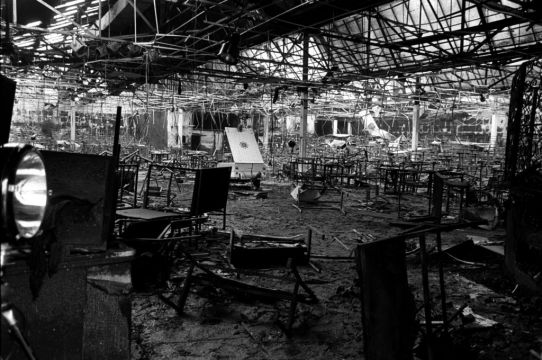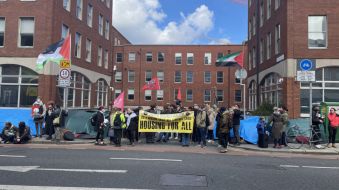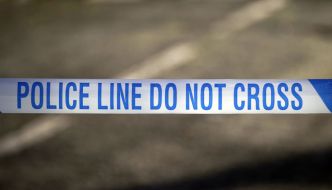The chief fire officer of Dublin Fire Brigade, the final witness to be called at the Stardust inquest, has told the jury that he believes an increase in the number of fire stations and firefighters in Dublin since 1981 was a direct result of the fire.
Dennis Keeley also told the jury in the Dublin District Coroner’s Court that it was “hard to disagree” it would be better for a third party to sign off on building plans rather than for builders or architects to self-certify.
Mr Keeley was asked to present factual evidence on Wednesday about the current preparedness of the emergency services, during the inquest into the fire that killed 48 people when it swept through the Stardust nightclub in the early hours of Valentine’s Day, 1981.
Mr Keeley told Mark Tottenham BL, a member of the coroner’s legal team, that the process of pre-incident planning has been in existence for nearly 20 years, and it deals with the gathering of intelligence should an incident happen.
He explained that the fire brigade seeks information from the owner-occupier of a building such as maps of the building, access and egress points, the location of hydrants or water sources, and any high-risk facilities that may be on site.
He confirmed that this information is available to fire crews while on route to an incident, explaining that this shortens the “get to work phase”.
He said that for large venues the brigade would have floor plans, which are maintained on laptops and are available to crews on route.
“Plans and drawings are generally followed up where possible by visits from local crews where they test that the hydrant is working, and they try to identify any anomalies or difficulties that could occur if they were to arrive,” Mr Keeley said.
He said that on an annual basis, the brigade manages to inspect around 70% of a total of around 1,200 licence applications each year, and the brigade strives to visit every premises at least once every two years.
“We visit at capacity, when it’s functioning, whether that’s going to be a weekend or a football match, we have our officers inspecting all the time. It is during the performance of the building, as there is little value in arriving when it is closed to the public,” he said, going on to say that 80 to 90% are unannounced inspections.
Emergency plan
Mr Tottenham asked how often the Dublin major emergency plan has been put into effect, in which an emergency response agency decides that the situation is “beyond the normal capabilities of the principal emergency services”.
Mr Keeley said that a specific declaration of that is very rare, and in a Dublin context he said he could not recall the last time it happened, perhaps the Raglan House explosion in 1987.
Mr Tottenham asked him about the recent public disturbance in O’Connell Street, to which Mr Keeley replied that while there were a number of fires, at no stage did the local authority feel that they could not cope.
He said that the authorities very regularly carry out multi agency exercises to prepare for the major emergency plan, with exercises taking place six to ten times a year.
Mr Tottenham said that evidence had been heard at this inquest of it taking three minutes from the first telephone call to emergency services on the night of the Stardust fire to the first fire engine being on the road, and he asked was this still the case.
“We strive for from the bell going in the station to the actual wheels turning at the gate being between 60 and 90 seconds,” said Mr Keeley.
Regulations
Mr Tottenham asked the witness if he had any comments to make about the Building Control Act Regulations (BCAR) and the issue of self-certification in relation to the building regulations.
“Since 2014 and the introduction of the BCAR, there has been significant improvement in building standards, and self-certification forms part of that process. We’re seeing a dramatic increase in building standards, so the competency of individuals for signing-off is functioning,” he said.
He said that the developments in building design will see rapid change in materials used and the design of buildings, and it would serve everyone if there was a more frequent review of the regulations.
Mr Tottenham asked the witness to what extent the practice within the Dublin Fire Brigade and Ireland been informed by the Stardust fire.
Mr Keeley replied that legislation has not been directly produced as a result of it, but updates of regulations would have been informed by it.
“Personally, I was employed in Dublin Fire Brigade in ‘86, and that’s probably as a direct result of the Stardust and the decision to increase the numbers within Dublin Fire Brigade and the need for additional stations,” he said, adding that increased staff training and the use of the best equipment was also a direct result of the Stardust fire.
Seán Guerin SC, representing a number of the families of the deceased, referenced the Place of Public Assembly process and asked whether the fire brigade have no part in the approval of the initial design of a building and any review after the building is completed.
Responsibility
Mr Keeley confirmed that it was not considered a routine part of the process for Dublin Fire Brigade to conduct an inspection during the construction process. He said that there are a number of inspections by building control inspectors, but this is not the responsibility of the fire brigade.
“The system that currently exists requires that the owner, builder and architect all have responsibility for ensuring that the structure is built in accordance with the regulations and the certificate that’s been issued.
“The prospect of examining every premises that requires a fire certificate at that level would be very onerous and extremely challenging. It would require an extreme amount of resources to manage,” said Mr Keeley.
He agreed with Mr Guerin that it was “hard to disagree” with the evidence of fire engineer Martin Davidson, who had told the inquest that it would be better for a third party to sign off on the plans rather than self-certification.
Bernard Condon SC, representing a number of families, said that Mr Davidson had said that other jurisdictions require that an annual fire safety assessment be carried out on public buildings, and Mr Condon put it to Mr Keeley that this was “a potential gap in the system here” in Ireland.
“Anything that improves the safety of the public has to be considered. The fire safety assessment on an annual basis would certainly be an advantage,” said Mr Keeley, adding that a form of evaluation of the fire risk assessment of any changes made to a building would be beneficial.
In response to a question from the jury asking the witness whether he considered there was any area of the current legislation that needed attention, Mr Keeley replied that the updating of technical guidance documents would be welcomed, as well as a faster capacity to review those documents.
At the conclusion of Mr Keeley’s evidence, coroner Dr Myra Cullinane said that this concluded the hearing of witness evidence in the inquest.
She told the jury to return tomorrow for a review of their documents and an opportunity to review photographic or video evidence, and she also informed all interested parties to make any submissions.
The inquest continues on Thursday in the Pillar Room of the Rotunda Hospital.







